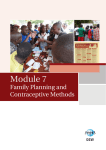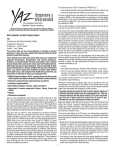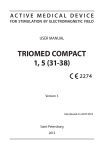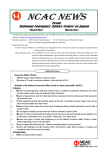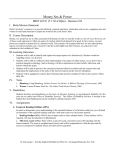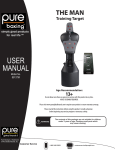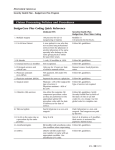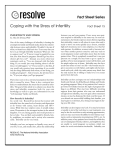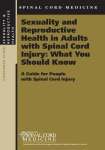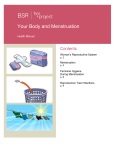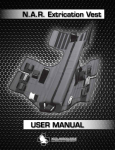Download Spinal Cord Injury - Patient Education Manual
Transcript
Spinal Cord Injury CHAPTER 8 Sexuality & Fertility For most people who are newly spinal cord injured, life and death decisions, physical comfort and settling into a regime of rehabilitation often take priority over issues of sexual functioning. However, when the immediate trauma has passed, people often begin to question what the future holds for employment, socialisation, recreation and intimate relationships. In other words, they begin to question their sexuality. It is difficult to define sexuality - and specifically, sexual functioning - because each person’s combination of injury and personality creates an individual picture. It has been said that while sex is something you do, sexuality is everything you are - your personhood. It may include the intimacy of the sexual act, but it also includes your personality and the social roles you play in your home and community. The biggest boost to sexuality has been rehabilitation that enhances mobility and health. Both contribute by allowing people to put their sexuality into action. In addition, people who are mobile and healthy find themselves in circumstances where relationships can develop. People may notice the wheelchair first. However, they will soon notice your sexuality, your interest in them, your manner and your shared interests. 10th Edition Dec 2008 8-1 Spinal Cord Injury Common Questions About Sexuality After Spinal Cord Injury Questions From Both Sexes: Will I Still Enjoy Having Sex? Will I have Orgasms? Both men and women question the ability to feel orgasmic. Will the sensation of ejaculation or genital stimulation result in a physical rush? Most people admit that this sensation is missing or altered following spinal cord injury. However, a majority of individuals find other avenues for sexual expression or release. Some have equated certain physical reactions to orgasmic response, others have found non-genital areas of their body that are highly sensitive. Will I Be Able to Satisfy My Partner? In addition to wanting functional information, most individuals with spinal cord injury admit that their changed functioning creates a new focus. They rediscover their sexuality - not just lovemaking, but in their daily lives. People willing to look at the total picture are reminded of the importance of courting, despite being married for many years. They are reminded of the importance of touch, even if it is not felt; the importance of visual images; the importance of complimenting of saying the other person’s name in fondness; the importance of a simple “I love you”; and the importance of not making every sexual contact end in genital focus. Many individuals become preoccupied with the question of function and whether they can please their partner. Interestingly, partners often report that this was not a concern before injury. It is unfortunate that only after crisis do most of us assess our partnership 10th Edition Dec 2008 8-2 Spinal Cord Injury roles. What Do I Do With My Catheter During Sex? It depends on what kind of catheter you use. Many leave their catheters in, often moving or taping them out of the way during intercourse. Some men fold the catheter over, along the penis, and keep it in position with a condom. Some people with indwelling catheters remove them before sex and replace them afterwards. However, you or your partner should be competent with catheter changes if you plan to remove your catheter each time. You may also increase the risk of urine infections with this option. What About Bowel and Bladder Accidents During Sex? Bowel and bladder accidents during sex can happen. Most people with spinal cord injury find that keeping to a regular bowel program helps prevent bowel accidents. If you are planning sexual activity, ensuring that the bladder is completely empty before sexual activity can prevent bladder accidents. Can I Still Get Sexually Transmitted Diseases Like Syphilis, Herpes & Aids? Yes. You are just as likely to get any of these as a non-injured person. A chart at the end of this section describes common symptoms of sexually transmitted diseases and tells you what to do if you have symptoms. How Do I Take Care Of This Part Of My Body? How Will I Know If Something’s Wrong? The best way to take care of your genital area is to wash regularly with soap and water 10th Edition Dec 2008 8-3 Spinal Cord Injury and dry thoroughly. As with other areas of your skin, inspect yourself closely for any signs of redness or infection. Where Can I Get More Information? The list of books at the end of this section will provide more information. Feel free to ask questions. You can ask the doctor, nurse, peer support advocate, or any therapist if you have questions. Questions Often Asked By Men Will I Be Able To Get An Erection? Men and women approach sexuality issues with different perspectives. Men with spinal cord injury inquire most about the ability to obtain erections. Once they are assured that most men with a spinal cord injury can achieve spontaneous (reflex) erections, their question then becomes how to sustain them. What Can I Do To Increase The Number Of My Erections And How Long They Last? Many medications may alter erection/ejaculation function. In particular, medications used for the management of spasm, spasticity and bladder. If you are having trouble with the number of erections or how long they last, first ask your consultant to discuss with you whether your medications may be responsible. Unfortunately an optimal system to help men obtain and maintain erections has not been 10th Edition Dec 2008 8-4 Spinal Cord Injury developed but work is being done to find a safe and effective solution. There are many kinds of sexual aids to help men obtain erections. There are basically two types - external or internal systems. Internal Systems When injected into the base of the penis, some chemicals such as prostaglandin E-1 or papaverine can stimulate an erection. However, these chemicals can have side effects and should be used only with physician guidance. One advantage of chemicals is that they are not permanent so you can try them to see if you are satisfied with the results. A penile implant uses rods that can be placed inside a man’s penis through surgery. There are different kinds of implants with different advantages. Penile implants have a good success rate, but as with all surgery there is a risk of complications. The surgery is permanent until the rods are removed. It is not known how men will function following the removal of these rods. External Systems Some men have indicated that simple positioning, such as hyperextending their legs, lying on their side or finding certain trigger points can assist in successful intercourse. However, other men may need vacuum entrapment devices to create the erection and constrictor rings to hold the erection for an extended period of time. These external management systems to aid erections have been in existence for quite some time. Only recently have they been accepted by the medical community, which may be due to the fact that there can be serious side-effects if they are not used properly. However, they are not 10th Edition Dec 2008 8-5 Spinal Cord Injury permanent, and they are relatively low in cost. Some systems are designed to enhance already existing erections. Medications There are also some medications that may be able to assist in gaining or maintaining an erection. These can be discussed with your consultant or urologist. In general, experts suggest that you take your time before deciding to pursue any of these options. It’s important to understand the advantages and disadvantages before making your decision. If you’re married or have a regular sex partner, that person should be involved in your decision as well. SIU staff can provide more information about erection devices. But if you are interested in these options, talk with your doctor or your urologist, the doctor who helps you with your catheter and bladder management. What Can I Do If My Wife And I Want To Have A Baby? It is possible for men with spinal cord injury to father children. However, special methods may need to be used to get ejaculates or to do inseminations. Some men report that they are able to obtain ejaculations through masturbation. Others say that if they remain erect sufficient for intercourse, they can sometimes trigger a reflex ejaculation. This is evidenced by the number of men who have fathered children through intercourse. 10th Edition Dec 2008 8-6 Spinal Cord Injury Others have achieved success using a commercial electric vibrator to trigger a reflex ejaculation, which is then used for artificial insemination. Many pregnancies have occurred using this method. You can be taught this technique, and any associated risks, in an outpatient clinic at Hampstead Rehabilitation Centre. For most couples, this technique can be managed in the privacy of your own home without any further medical intervention. Still another method used is electroejaculation. This procedure is carried out by a physician. A probe that conducts electrical impulses is inserted into the rectum. These electrical impulses stimulate an ejaculation. The external or retrograded ejaculations (semen entering the bladder) are collected and processed for use in insemination. Again, numerous pregnancies have resulted from this technique. There are other less used techniques including drugs that stimulate ejaculation. All methods of assistance to obtain a pregnancy should be discussed with your SIU doctor first. The SIU Outpatient Department may be able to offer techniques for no, or minimal, cost. These avenues should be tried before assistance from (often expensive) other hospital agencies is explored. Some techniques may have associated complications, such as triggering autonomic hyperreflexia. Your SIU doctor will be aware of this and monitor the likely effects. 10th Edition Dec 2008 8-7 Spinal Cord Injury The cost of assisted pregnancies increases with the degree of clinical processing and all methods should be discussed with a physician, since medical complications can result from any of these procedures. Questions Often Asked By Women Women with spinal cord injuries generally want to read books or articles by women in a similar situation, to review peer videos and participate in women’s information or community support groups. Their questions include issues such as personal hygiene techniques, bladder management, contraception, management of monthly periods, clothing styles, vocational pursuits and home management. They also want to know if their genitals will respond to sexual stimulation and whether they will be viewed as satisfying sexual partners. Can I Still Get Pregnant? Yes, a woman’s reproductive system is controlled by systems outside of the central nervous system so it is unaffected by spinal cord injury. If you have intercourse you are just as likely to get pregnant following injury as you were before injury. Why Did My Period Stop? After spinal cord injury a woman’s menstrual period may stop for a few months because of the shock her body has undergone. Periods should resume within six months of injury. 10th Edition Dec 2008 8-8 Spinal Cord Injury Does This Mean I Need Birth Control? What Kind Is Good? You will need to use birth control if you do not want a pregnancy. However, your injury can make some types of birth control harder to use. There may be other considerations as well. A chart at the end of this section lists different methods and the advantages and disadvantages of each. You should discuss birth control methods with your gynaecologist or GP. What Is A Gynaecologist? A gynaecologist is a doctor that specialises in examining and treating a women’s reproductive organs. Every woman, whether she is disabled or able-bodied, should see a gynaecologist at least once a year. A gynaecologist will give you an assessment that includes a PAP smear (a test of the mucus in your cervix), a pelvic examination (checking the cervix, vagina, uterus and ovaries), and a breast examination (checking the breasts for lumps or any changes in texture). Your GP, Women’s Health Centre health worker or SHINE (Sexual Health Information and Networking Education Inc, formerly Family Planning Association) can also do this. How Do I Find A Gynaecologist? You can ask your doctor, staff at a rehabilitation centre, or other disabled women for suggestions. You should check on two things when you call for an appointment: 1. Is the office wheelchair accessible? 2. Can staff members assist you with transfers and undressing as needed? 10th Edition Dec 2008 8-9 Spinal Cord Injury If I Decide To Have A Baby, Will I Have Special Problems? There are special considerations but none should prevent you from having a baby. Most women with spinal cord injuries can have a normal delivery. However, most women stress the importance of preventing urinary tract infections due to bladder changes during pregnancy. They also cite increased problems that can occur, including pressure sores, anaemia, constipation, increased spasticity and potential for blood clots. Maintaining a modified diet is also important to prevent excessive weight gain. To deal with these problems, it is important for your doctor to understand spinal cord injury. Also, plan ahead. Will you need help getting around while you’re pregnant? Or will you need help taking care of your baby? How much will this cost? Talking with other disabled women who have had children can help in your planning. Will I Need A Caesarean Section To Deliver The Baby? Testimony by mothers with spinal cord injury indicate that they felt delivery was more natural since the body doesn’t fight against the delivery process. In general, vaginal delivery was preferred with no indication for Caesarean section in most cases. If preplanning is done with the physician and staff, complications generally can be avoided. Most women with injuries T-10 and above reported painless labour without the need for anaesthesia. Are There Risks To The Baby? There appears to be no greater risk for birth defects or other health problems in babies 10th Edition Dec 2008 8-10 Spinal Cord Injury born to women with spinal cord injury. Most problems that may happen during labour and delivery can be prevented with planning and with knowledgeable physician care. Should I Use Tampons Or Napkins During My Menstrual Periods? You can use either. Some women prefer tampons because they don’t cause skin irritation and give you better protection during transfers. You should change them often - at least three times a day - to avoid the risk of toxic shock syndrome. If you have trouble inserting a tampon due to limited hand function, try using a lubricated tampon or get your carer to assist you. If you use napkins, check regularly for signs of skin irritation and pressure between your legs. Exploring Your Sexuality Despite changes in sensation and response, people with spinal cord injuries report that they have a satisfying sexual life following injury. As is true with any relationship, the key to satisfactory sexual experience is good communication. Being aware of your partner’s likes and dislikes and being able to express your own are fundamental to good communication. Some experimentation can enhance sexual pleasure. Experimentation can involve physical contact such as changes in sexual positioning or techniques, or it can involve emotional options such as courting. Some options will appeal to you and others will not; the important thing in every case is that you use ideas that are comfortable for you. 10th Edition Dec 2008 8-11 Spinal Cord Injury Many spinal cord injured people have found that the traditional position of the man on top is not the most satisfying for either partner. This can be especially true if the injured partner is male. Using a side-to-side or women on top position in this case, allows the woman to be the more active partner and gives the man free use of his hands. Some people with spinal cord injuries find that they have increased sensitivity in the area just above their loss of sensation. Having their partner stroke and caress this area can be very pleasurable. Others mention that fantasy and even sharing these fantasies with their partners enhance their sexual experience. Couples also enjoy manual or oral stimulation as part of their sexual activity. Sexual devices such as vibrators may also increase enjoyment. Again, personal values and preferences should be your guide. Some people with spinal cord injuries say that their sex lives are better after injury. One reason for this is that they feel they develop a greater closeness with their partner. Many rediscover the joys of courting - the slow process of getting to know each other as individuals. Still other persons find that they are willing to explore new areas of sensuality. They are open to using body oils or lotions or to giving a massage, all of which enhance the sexual experience in ways that are difficult to describe. As we said in the introduction, sex is an act and sexuality is who you are. The more you and your partner can share your uniqueness in a sexual relationship, the more satisfying that relationship will become. 10th Edition Dec 2008 8-12 Spinal Cord Injury Suggestions for Managing your Menstrual Cycle: Women who use tampons: Always make sure the tampon is inserted correctly. Depending on your sensation, you may not be able to feel were the tampon is positioned. A suggestion to help you with this would be learning on the bed like you would learn to do self-catheterisation. Using a mirror, look at your vagina and practice inserting the tampon so you become familiar with your vaginal shape. Everyone is shaped differently so you will have to become aware of what is right for you. Once you have become familiar with inserting the tampon and you have proceeded with doing self-catheterisation, it may be easier to remove the tampon before doing a catheter. This can remind you to remember to remove the tampon as it is recommended to replace the tampon every 4 hours. After removing the tampon you may be a little dry, so if you don’t normally use gel on the catheter you may need to use a little bit on the catheter before you insert it. You can also use a little gel on the tampon if you still are a little dry. (Please refer to The Spinal Injury Rehabilitation Manual in the glossary section in regards to “Toxic Shock Syndrome”) 10th Edition Dec 2008 8-13 Spinal Cord Injury 1. Sanitary Napkins The thickness of the pad you would use would depend on how heavy your periods are. For ladies doing self-catheters, make sure you use pads that stick well to your underpants. When you are sitting, always make sure the pad is positioned even and back more towards your anus. This is because the blood tends to flow in that direction while you are sitting. Before catheterising gently wipe away the blood with soft toilet tissue or cloth and always wipe downwards to avoid any faecal contamination. After this you may be a little dry so you may require a little gel on your catheter. Remember: Always make sure you wash your hands before and after and be as clean as you can be. For ladies who would like to use pads and have an indwelling catheter, if you are someone who has heavy periods and requires using a thicker pad, you may have trouble fitting it around the catheter. A suggestion could be to cut down the middle of the pad so it can fit more easily around the catheter tube. Make sure you have more pad sitting back towards your anus, as blood tends to flow back more than if you were walking around. Try and wear firm fitting underpants to lessen the movement of the pad. If someone is assisting you with putting the pad on, make sure it is sitting flat and evenly so it is not causing pressure (you will also lessen the chance of getting blood on your clothes). If you do experience having trouble with this, you could use incontinence pads, as they are thicker and longer and thus provide you with more protection. Sanitary napkins for nighttime use are also longer than normal. You can purchase any of these items at larger supermarkets 10th Edition Dec 2008 8-14 Spinal Cord Injury Other choices: Depend pads - If you are going out, these are also good for extra protection when travelling if you are concerned regarding incontinence problems. “Tena” also has large incontinence pads that are longer than a normal sanitary pad and can be used for heavier periods. Other choices can be discussed with your Spinal Injuries Doctor, GP or Gynaecologist who will provide medical options to suit your individual needs. 10th Edition Dec 2008 8-15 Spinal Cord Injury Where Can You Get More Information? Within the Spinal Injury Unit: ¾ Any member of your rehabilitation team. ¾ During your Outpatient Department visits. ¾ Resources of books/articles etc are available from: - PQA Peer Support Advocates - SPARC Rec’n’Rehab Liaison Officer - Clinical Psychologist - Your Consultant - Your Social Worker Within the Community: ¾ Women’s Health Statewide Centre ¾ ¾ Men’s Information and Support Centre SHINE SA 64 Pennington Tce, North Adelaide Torrens Building, 220 Victoria Square 17 Phillips St, Kensington ¾ Relationships Australia (SA) Inc 55 Hutt St, Adelaide 8223-4144 ¾ Gay, Lesbian Psychology and Counselling Services Sturt Road, Marion 8411-0996 ¾ Gay Men’s Health 64 Fullarton Road, Norwood 8334-1617 10th Edition Dec 2008 8239-9600 Freecall 1800-182-098 8212-0331 8431-5177 8-16 Spinal Cord Injury Charts & Resources Sexually Transmitted Diseases Symptoms ¾ ¾ ¾ Other Symptoms (You may or may not feel these depending on the level and completeness of your injury). What To Do: If you have a symptom: If you have an STD: ¾ ¾ ¾ ¾ ¾ ¾ ¾ ¾ 10th Edition Unusual discharge from penis or vagina (discharge could look milky, bubbly, be a strange colour or be bad-smelling). Lumps or bumps in genital area. Sores in genital area. Itching in genital area. Burning during urination. Abdominal pain. Fever. See your doctor. Take the medicine the doctor prescribes. Take all of it. Tell all of your sexual partners. Encourage them to have check-ups whether they have symptoms or not. Go back to the doctor for a follow-up exam. Make sure the infection is totally gone. Dec 2008 8-17 Spinal Cord Injury Signs of Disease/Infection (Male) What To Check: Testicles Who Does Check: You or a carer When: Monthly How To Do: ¾ ¾ ¾ Feel for lumps or swelling of testicles or scrotum. Look for reddened skin on scrotum. Notice any change. If You Notice A Change: What To Check: See your doctor Bladder drainage Who Does Check: You When: Daily How To Do: Be aware of: ¾ An unusually large amount of clear drainage if you have a urethral catheter. ¾ Drainage that is thick, pus-like, grey, green or yellow. ¾ Blood in drainage. If You Notice A Change: See your doctor Signs of Disease/Infection (Female) What To Check: Breasts Who Does Check: You or a carer When: Monthly How To Do: Feel breasts and surrounding area for: ¾ Lumps. ¾ Thickening. ¾ Any changes. If You Notice A Change: What To Check: See your doctor Vaginal discharge Who Does Check: You or a carer When: Daily How To Do: Be aware of discharge that is: ¾ Very thick. ¾ Like cottage cheese. ¾ Bubbly. ¾ Grey, green or yellow. ¾ Bad smelling. ¾ Causing redness or a rash. If You Notice A Change: See your doctor 10th Edition Dec 2008 8-18 Spinal Cord Injury Which Birth Control Methods Might Suit You Type Spermicides Advantages Disadvantages 1. 2. 3. 4. Easy to obtain, no prescription. Can use only as needed. More effective if used with a condom. Provides vaginal lubrication. Contraceptive Sponge 1. 2. 3. 4. 5. 6. 7. 8. Easy to obtain, no prescription. May be used for repeated intercourse. May be inserted several hours before. Easy to insert and remove if full hand function. Do not need to add spermicide. Sponge absorbs semen, making method less messy. String loop assists removal. More effective if used with a condom. Diaphragm 1. 2. 3. 4. Can be used only when needed. Very effective when used correctly. No side effects. More effective if used with condom. Cervical Cap 1. 2. 3. 4. No side effects. May be worn longer than diaphragm. Less spermicide needed than with diaphragm. Can be used by women who cannot use a diaphragm due to loose vaginal muscles or bladder problems. More effective if used with condom. 5. 8-19 1. Must be used at time of intercourse, can limit spontaneity. 2. Somewhat messy, may discourage oral sex. 3. Insertion may be difficult if hand function limited. 4. Chemicals may irritate both partners. 5. Often considered less effective. 1. May have difficulty removing, sponge may tear. 2. Requires full hand function to insert. 3. Must be left in 6 hours after intercourse. 4. Occasionally irritates male partner. 5. Must not be used: ¾ during menstruation (Toxic Shock risk). ¾ if you have had Toxic Shock Syndrome. ¾ for 12 weeks after giving birth. 6. Often less effective. 1. Can cause pressure against bladder, leading to infections or unexpected urination. 2. May become dislodged in women with relaxed vagina. 3. Fit must be re-examined periodically. 1. Requires full hand function for insertion. 2. Cap cannot be used if you have had an abnormal PAP smear, Toxic Shock or vaginitis cervicitis. Spinal Cord Injury Which Birth Control Methods Might Suit You Type Advantages Condom 1. 2. 3. 4. 5. 6. Birth Control Pills 1. 2. 3. 4. 5. 6. 7. 8. 1. Rhythm 2. 3. 4. Disadvantages Protection against sexually transmitted diseases. Easy to obtain, no prescription. Easy to use and dispose of. No side effects. Can use only when needed. More effective if used with spermicide or barrier such as diaphragm. Make periods more regular with less cramping. Shorter period with less blood. Convenient to use. Decreased risk of ovarian and endometrial cancer. Less chance of pelvic inflammatory disease. Less chance of benign breast disease. Very effective in preventing pregnancy. Can predict start of menstrual periods. May be acceptable to couples having religious concerns about other forms of birth control. No side effects. Minimal cost. Can predict start of menstrual periods. 8-20 1. 2. 3. 4. 5. 6. May leak or tear, especially if dried out. Preparation necessary, may limit spontaneity. May decrease sensation for male. Requires cooperation of male. May require using artificial lubricant. Failure rate great if used alone. 1. Weight gain possible, causing mobility problems. 2. Possible interaction with other medication that reduce effectiveness of pill. 3. High risk of blood clots in SCI women. 4. SCI women may be unaware of pain associated with blood clots. 5. Potential risk of cardiovascular disease, strokes, high blood pressure, breast cancer. 1. Taking the temperature daily and record-keeping may be a problem. 2. Temperature or mucus checks may be difficult if hand function is limited. 3. Must have ‘regular’ cycle to use. 4. Certain life stresses may alter monthly cycle. 5. Requires self-control and planning, limiting spontaneity. 6. Considered least effective method. Spinal Cord Injury Which Birth Control Methods Might Suit You Type Sterilisation Norplant IUD’s Advantages Disadvantages 1. Surgery 99.9% effective, no other method ever needed. 2. Does not interfere with hormone production, sex drive, or orgasmic response. 3. After initial surgery, health risks are low. 1. Very effective - as effective as birth control pills. 2. Easy insertion procedure. 3. Can be in place for up to 5 years. 4. Allows spontaneity. 5. No hand function required. 1. Very effective. 2. Can be in place for 5 to 8 years, depending on the type. 3. Allows spontaneity. 4. Easy insertion procedure. 8-21 1. Fertility can seldom be restored, some chance with vasectomy. 2. Possibility of swelling, bleeding, hyperreflexia, or infection during or after surgery. 1. Side effects may include irregular bleeding. 2. No long-term studies regarding blood clots in SCI persons. 1. May cause heavier, more painful menses. 2. Increased risk for pelvic infection in women with multiple sexual partners. Spinal Cord Injury The Reproductive Systems And Sexual Response Cycle This section lists the parts of the male and female reproductive systems and describes how they work. It also describes the normal sexual response cycle and how things can change following spinal cord injury. The Male Reproductive System The parts of the male reproductive system are described below. They are: ¾ The testes (or gonads), two oval-shaped male sex glands contained in a pouch of skin called the scrotum. The testes produce sperm, which can fertilise the female’s egg and result in pregnancy. Testes also produce hormones that cause male sex characteristics such as a deep voice and facial hair. ¾ Sperm moves from the testes into the epididymis, a coiled tube, where sperm is stored. ¾ As sexual excitement builds, sperm moves from the epididymis through a tube called the vas deferens. During this movement, sperm is joined by fluids released from the seminal vesicles, the cowpers glands, and the prostate gland. Sperm and these lubricants together form semen. ¾ Semen moves into the urethra, a tube that allows both semen and urine to pass out of the body. ¾ The urethra runs through the penis. The penis is the external male sex organ, filled with spongy tissue that can retain blood. It contains two shafts called the corpora cavernosa. During sexual excitement, these shafts fill with blood, making the penis larger and harder, causing an erection. ¾ During orgasm and ejaculation, muscle contractions force semen out through the 8-22 Spinal Cord Injury urethra. When ejaculation occurs during sexual intercourse, the sperm travels up into the woman’s body and can fertilise an egg, if one is present. The Female Reproductive System The parts of the female reproductive system are described below. They are: ¾ The ovaries, two oval-shaped female sex organs, one of which releases an egg each month. When the female’s egg combines with the male’s sperm, fertilisation occurs. The ovaries also produce hormones that generate female sex characteristics, such as breast development and a wider pelvis. ¾ As an egg is released from an ovary, it is drawn into one of the fallopian tubes, where it can be fertilised. ¾ From the fallopian tube, the egg moves into the uterus, whether it has been fertilised or not. The uterus is a pear-shaped mass of muscle located deep inside the lower abdomen. The primary function of the uterus is to house and protect the developing baby. During pregnancy, muscle fibres of the uterus stretch as the foetus grows. ¾ The uterus lining is called the endometrium. This lining nourishes the baby as it grows. If no egg is fertilised, the endometrium is shed during menstruation. This becomes monthly bleeding. ¾ The uterus has a narrow neck called the cervix. In the centre of the cervix is a tiny hole called the os, which leads to the vagina. ¾ The vagina is a muscular tube 5 or 6 inches long that connects the uterus to the outside of the body. It has a moist lining that allows the vagina to perform three major functions: entryway for the penis and for sperm during intercourse, exit for menstrual fluid, and passageway for the baby during birth. 8-23 Spinal Cord Injury ¾ The vulva is the name for a woman’s external sex organs. These include the major labia (lips), which protect the opening of the vagina and are covered with hair as added protection. The minor labia (lips) directly cover the opening to the vagina. ¾ The clitoris, located on the minor labia, is the female counterpart to the penis because it is capable of erection, and stimulation can lead to orgasm. However, orgasm is not essential for fertilisation to take place. ¾ The urethra, located below the clitoris, allows urine to pass from the body. It is not connected to the sexual process. Sexual Response Cycle The sexual response cycle is the term used to describe the phases and bodily changes that result from sexual stimulation. The sexual response cycle has four phases. Both men and women can experience all the phases, but their partners may be different. Phase One is called the excitement phase. This is the beginning of sexual stirring’s and could involve sexual thoughts and fantasy as well as actual physical touch. During the excitement phase, the man’s penis fills with blood and becomes erect. An erection can be caused just by thought, and this is called a psychogenic erection. An erection also can be caused by touch or response to another physical stimulation, like a full bladder. This is called a reflexogenic erection. An able-bodied male in the excitement phase usually has an erection caused by a combination of mental and physical stimulation. The woman’s clitoris also becomes erect during the excitement phase. Her vagina will 8-24 Spinal Cord Injury become more moist to make intercourse easier. This is called lubrication. Her breasts will become more sensitive and her nipples will become erect. Phase Two is called the plateau phase. It is a combination of the pleasurable feelings begun in the excitement phase. Both sexes may have an increased heart rate, heavier breathing, and a sex flush. In men, the sperm begins to travel though the urethra. This movement is called emission. Phase Three is called the orgasmic phase. In this phase, both sexes can experience contractions in the genital area that may be viewed as very pleasurable. In men, these contractions can lead to ejaculation, or forcing of the semen out through the urethra. However, neither an erection nor an orgasm are necessary for emission and ejaculation to occur. Similarly, the woman can become pregnant when the sperm enters her vagina, whether or not she experiences orgasm. Phase Four is called the resolution phase. This phase is a return to the normal body state, as blood pressure, heart rate, and breathing all return to normal. Both sexes may feel sleepy and relaxed. Reproductive System & Response Cycle After Spinal Cord Injury It is difficult to know what your sexual experience will be like after your injury. We are all individuals, and no where more so than in the area of sexual response. Studies of men with spinal cord injuries indicate that what is felt or not felt depends on the level and completeness of injury. There has been little study of sexual response in women with 8-25 Spinal Cord Injury spinal cord injuries, so we can only assume that level and completeness of injury also will affect their response. Some Changes That Are Common For Men Erections are usually caused by a combination of mental and physical stimulation. After spinal cord injury, a man’s erections may be mentally stimulated only or physically stimulated only, depending on the level and completeness of his injury. Also, erections may not last long enough for intercourse. There also may be changes in the emission of sperm (when sperm starts to travel through the urethra) and in the ejaculation of sperm (when it is forced out the end of the penis). These changes can cause fertility problems. Finally, orgasmic feelings may be experienced differently. Although some physical sensation is lost, some people with spinal cord injuries say they still have orgasmic sensations and that these are similar to their experiences before injury. Some Changes That Are Common For Women A woman’s menstrual periods often stop temporarily after spinal cord injury, but usually start again within six months or less. Once her menstrual periods resume, she is as fertile as she was before the injury. 8-26 Spinal Cord Injury Genital stimulation in the woman is influenced by both mental and physical stimulation. After spinal cord injury, this stimulation may be mental or physical only, depending on the level and completeness of the injury. Lubrication of the vagina, which takes place during the excitement phase, also may change after spinal cord injury. Some women find they lubricate less; some find it takes longer. Finally, as in men with spinal cord injuries, women with spinal cord injuries may experience orgasmic sensations differently than before injury. Although some physical sensation is lost, some people with spinal cord injuries say they still have orgasmic sensations and that these are similar to the experiences before injury. Some women may experience pain during sex. There is a gel that can be used to dull the pain. You should ask a doctor if this is an issue for you. 8-27 Spinal Cord Injury Vas Deferens Epididymis Cross Section View of Male Teste. Illustration adapted from: The A&P Workbook, A Complete Study Guide to Anatomy and Physiology, Marieb, E.. 8-28 Spinal Cord Injury Bladder Seminal vesicle Symphysis Pubis Ejaculatory Duct Prostate Gland Vas Deferens Rectum Cowper’s gland Epididymis Testis Scrotum Penis Prepuce Cross Section View of Male Pelvic Cavity & Reproductive organs. Illustration reproduced from: The A&P Workbook, A Complete Study Guide to Anatomy and Physiology, Marieb, E.. 8-29 Spinal Cord Injury Fimbriae Ovary Sacrum Fallopian Tube Broad Ligament Uterus Cervix Bladder Urethra Rectum Symphysis Pubis Clitoris Vagina Anus Labia Majora Illustration reproduced from: The A&P Workbook, A Complete Study Guide to Anatomy and Physiology, Marieb, E.. 8-30 Spinal Cord Injury The Vulva: Mons Pubis Labia Majora (spread) Clitoris Urethral orifice Labia Minora Hymen Vaginal orifice Anus Illustration reproduced from: The A&P Workbook, A Complete Study Guide to Anatomy and Physiology, Marieb, E.. 8-31


































